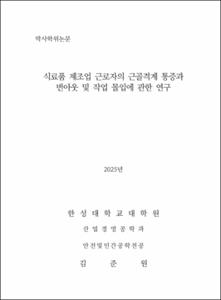식료품 제조업 근로자의 근골격계 통증과 번아웃 및 작업 몰입에 관한 연구
= A Study on Musculoskeletal Pain, Burnout, and Work Engagement among Food Manufacturing Workers
- Files in This Item:
-
-
Download
 200000851275.pdf
기타 데이터 / 1.23 MB / Adobe PDF
200000851275.pdf
기타 데이터 / 1.23 MB / Adobe PDF
-
Items in Repository are protected by copyright, with all rights reserved, unless otherwise indicated.